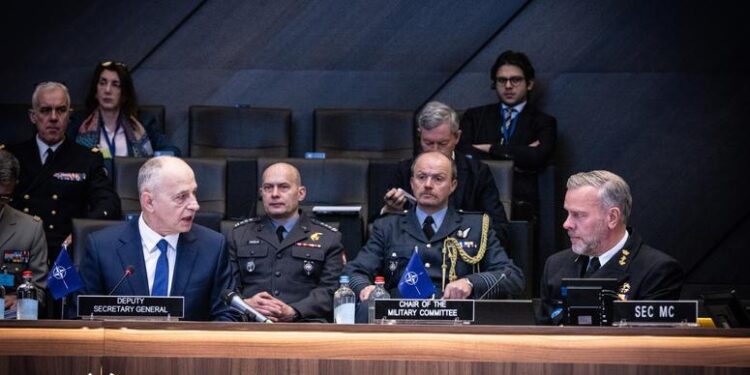On March 26, 2025, the NATO military Committee undertook a important visit to Sweden, underscoring the alliance’s commitment to regional security and collaboration among member nations. This visit highlights NATO’s ongoing efforts to strengthen partnerships and enhance military readiness in the face of evolving global threats. The meeting brought together high-ranking military officials from various NATO countries, focusing on strategic defense initiatives and fostering cooperative military engagement. As geopolitical tensions escalate in various parts of the world, Sweden’s role within NATO has become increasingly critical, prompting discussions about collective defense, crisis management, and the importance of unity among allies. This article delves into the key discussions and outcomes of the NATO Military Committee’s visit, shedding light on it’s implications for Sweden and the broader NATO alliance.
NATO Military Committee’s Historic Visit to Sweden
The NATO military Committee’s visit to Sweden marks a significant milestone in strengthening ties between NATO and its Nordic partners. This visit underscores NATO’s commitment to enhancing collective defense and security in the region, especially in light of evolving geopolitical challenges. military leaders engaged in strategic discussions focused on furthering cooperation in various domains, including air, land, and maritime operations. Key highlights from their meetings include:
- Joint Military Exercises: Plans for enhanced joint training initiatives to improve readiness.
- Cyber Defense: Strengthening mutual support in combating cyber threats.
- Intelligence Sharing: Expanding frameworks for real-time data exchange.
The visit also featured a series of briefings that allowed NATO officials to gain insights into Sweden’s defense capabilities and strategic priorities. Alongside these discussions, a military presentation showcased Sweden’s advanced logistics and technology integration.This event not only highlighted Sweden’s role in NATO’s broader security framework but also facilitated discussions around collaborative approaches to addressing regional security concerns. Below is a summary of the visit’s key points:
| Focus Area | Outcomes |
|---|---|
| Defense Cooperation | enhanced joint operational readiness |
| Regional Security | Commitment to collective defense initiatives |
| Future Collaborations | Ongoing dialogues on strategic partnerships |
Strengthening Defense Collaboration between NATO and Sweden
The recent visit by the NATO Military Committee to Sweden marks a significant stride in bolstering defense ties between the alliance and the Nordic nation. This engagement highlights the shared commitment to collective security in an increasingly unpredictable global landscape. Key discussions during the visit focused on enhancing interoperability between NATO forces and Swedish military capabilities, aligning strategies to counter emerging threats, and integrating Sweden into NATO’s defense frameworks more comprehensively. The mutual benefits of closer collaboration include streamlined operations, improved readiness, and a unified response to crises.
To facilitate this strengthened partnership, several initiatives have been proposed, such as:
- Joint Training Exercises: Increased frequency of joint drills to promote compatibility among forces.
- intelligence Sharing: Enhanced mechanisms for the exchange of critical intelligence to preempt threats.
- Technological collaboration: Joint ventures in defense technology to bolster innovation and capability.
Furthermore, a recent meeting of defense leaders has established a new framework for cooperation, which includes a series of upcoming meetings and collaborative workshops focused on maritime security in the Baltic Sea. As part of these efforts, the following milestones have been set for the next two years:
| Year | Milestone | date |
|---|---|---|
| 2025 | Joint Naval Exercise | June 15 |
| 2026 | Cyber Defense Symposium | March 12 |
| 2026 | Air Force Collaborative Training | November 8 |
These initiatives not only affirm the commitment of both NATO and Sweden to peace and stability in the region but also serve to enhance deterrence capabilities against potential aggressors. As the alliance continues to adapt, the integration of Sweden stands as a testament to its strategic importance in the evolving defense landscape.
Key Discussions between NATO Officials and Swedish Leadership
The recent discussions between NATO officials and Swedish leadership centered around several pivotal topics reinforcing the alliance’s collective security framework. Key talking points included:
- Enhanced Defense Collaboration: A commitment to strengthening joint military exercises and interoperability among NATO and Swedish forces was emphasized, ensuring readiness in the face of emerging threats.
- Cybersecurity Initiatives: Both parties expressed a mutual interest in fortifying cyber defenses, recognizing the need for advanced technology sharing and collaborative threat intelligence mechanisms.
- Regional Stability: The discussions acknowledged the geopolitical landscape of the Baltic Sea region and the importance of maintaining a robust presence to deter potential aggression from adversarial states.
Moreover, the NATO delegation provided insights on the Alliance’s strategic priorities moving forward, with an emphasis on:
| Strategic Priority | Description |
|---|---|
| Deterrence and Defense | Focus on maintaining a credible deterrent capability against regional threats. |
| Rapid Response Forces | Enhancement of NATO’s rapid response capabilities through better coordination and resource allocation. |
| Partnership Expansion | Encouraging greater cooperation with partner nations to support global security efforts. |
Strategic Implications of Sweden’s Enhanced Military Readiness
Sweden’s recent steps to enhance its military readiness signal a pivotal shift in the Baltic region’s security landscape. As NATO’s military Committee visits the nation, the implications of this growth go beyond mere defense preparedness. By increasing military capabilities and participating in joint exercises, Sweden is not only reinforcing its own national security but also demonstrating its commitment to collective defense principles enshrined in NATO. This proactive stance strengthens the alliance’s deterrence posture against potential aggressors, thereby contributing to regional stability.
Moreover, the enhanced military readiness of Sweden may compel neighboring countries to reevaluate their defense strategies and military collaborations. With the prospect of deeper integration in NATO frameworks,the following strategic implications arise:
- Increased NATO Presence: The likelihood of permanent NATO bases in sweden could become a reality,enhancing response times in crises.
- Joint Military Exercises: Regular drills with NATO allies will improve interoperability and trust among member states.
- Error Margin Reduction: Enhanced intelligence sharing will lead to more informed decision-making and quicker reactions.
Focus on Regional Security: NATO’s Perspective on Northern Europe
The recent visit of NATO’s Military Committee to Sweden highlights the alliance’s commitment to strengthening regional security, particularly in Northern Europe. This visit comes at a crucial time as geopolitical tensions escalate, prompting discussions around enhanced military collaboration and defense strategies. Key topics addressed included:
- Strengthening Defense Postures: Emphasizing the significance of a robust presence in the Baltic Sea region.
- Joint Exercises: Planning future joint military exercises to improve interoperability among member nations.
- Cybersecurity Initiatives: Enhancing resilience against cyber threats faced by Northern European nations.
during the meeting, delegates acknowledged the strategic importance of Northern Europe in the context of NATOŌĆÖs collective defense framework. They discussed the need for an increased focus on intelligence sharing and logistics to bolster rapid response capabilities. The committee also reviewed recent developments in military technology, aiming to harness these innovations to better respond to evolving security challenges. A summary of key initiatives discussed is illustrated in the table below:
| Initiative | Description |
|---|---|
| Enhanced Defense Framework | Aligning military assets across member nations for immediate deployment. |
| Cyber Defense Protocols | Developing thorough strategies to combat cyber threats. |
| Interoperability Training | Conducting regular exercises to ensure cohesive operations. |
Strengthening Joint Exercises and Training Programs
The NATO Military Committee’s recent visit to Sweden signifies a renewed commitment to enhancing collaborative defense initiatives among member nations.One of the key outcomes of this visit is the emphasis on. By fostering interoperability and cohesion among armed forces, NATO seeks to ensure that its members are well-equipped to tackle emerging security challenges. This approach not only enhances military readiness but also builds trust and camaraderie among allied nations.
To achieve these objectives, the following strategies are being prioritized:
- Integrated Training sessions: conducting joint exercises that simulate real-world scenarios, allowing forces to develop tactical synergies.
- Cross-National Workshops: hosting collaborative workshops to share best practices and innovative strategies across member states.
- Resource Sharing: Pooling resources and expertise to maximize the efficiency and effectiveness of training programs.
- Strengthening Dialog: Establishing robust communication frameworks to facilitate coordination during joint operations.
these initiatives reflect NATO’s strategic vision of a more adaptable and resilient defense posture. by integrating these practices into routine military operations, member countries can ensure a unified response to any potential threat, thereby reinforcing the collective security framework that NATO represents.
Recommendations for future NATO-Sweden Partnerships
As NATO seeks to expand its influence and interoperability with Sweden, several key strategies should be considered to strengthen future partnerships. First and foremost, enhancing joint training exercises can substantially improve readiness and cooperation. This could include:
- Coordinated air and naval drills to practice rapid deployment capabilities.
- Cybersecurity exercises aimed at improving defenses against hybrid warfare.
- Joint humanitarian assistance operations to address potential crises.
Moreover, fostering collaborative defense initiatives can definitely help integrate Sweden more deeply into the NATO framework. Establishing working groups focused on critical areas such as supply chain resilience and logistics would be beneficial. The potential creation of a structured framework for intelligence sharing will also empower both NATO and Sweden to address emerging security challenges more effectively. To visualize these recommendations,the table below outlines possible focus areas and objectives:
| Focus Area | Objectives |
|---|---|
| Joint Military Exercises | Enhance readiness and interoperability |
| Cybersecurity Collaboration | Strengthen defenses against hybrid threats |
| Intelligence Sharing | Improve situational awareness and response |
The Role of Sweden in NATO’s Evolving Security Strategy
Sweden’s strategic location and its robust defense capabilities are increasingly recognized as pivotal elements in NATO’s updated security framework. The NATO Military CommitteeŌĆÖs visit to Sweden underscores the importance of enhancing regional security cooperation. As tensions in Eastern Europe persist, Sweden acts as a bridge between NATO member states and Nordic partners, facilitating a unified response to potential threats. Key aspects of Sweden’s role include:
- Geopolitical Importance: Control over the Baltic Sea routes enhances NATOŌĆÖs operational reach.
- Defense Collaboration: Participation in joint exercises and intelligence sharing strengthens collective defense.
- military Capabilities: Sweden’s advanced air and naval forces contribute significantly to NATOŌĆÖs deterrence strategy.
Furthermore, SwedenŌĆÖs commitment to defense spending and modernization aligns with NATOŌĆÖs emphasis on burden-sharing among allies. Recent developments indicate increased bilateral cooperation between Sweden and NATO powers, particularly in areas such as cyber defense and crisis management. An overview of Sweden’s contributions and future engagements includes:
| Focus Areas | Details |
|---|---|
| Joint Exercises | Participation in large-scale NATO drills to enhance interoperability. |
| Cybersecurity | investing in cyber defense initiatives in partnership with NATO. |
| Supply Chain Security | Collaborating on logistics to ensure rapid deployment capabilities. |
Insights from NATO’s Latest Military Assessments
NATO’s latest military assessments offer a comprehensive overview of the evolving security landscape,emphasizing the alliance’s adaptability in the face of emerging threats. Key highlights from the assessments include:
- Heightened Readiness: Member nations are emphasizing rapid response capabilities, with increased joint exercises and training initiatives.
- Cyber Defense Enhancements: Acknowledging the rise in cyber threats, enhanced strategies are being developed for collective cyber defense.
- Resource Allocation: The necessity for equitable burden-sharing has lead to strategic discussions on resource optimization and military funding.
The ongoing collaboration between military and civilian sectors is particularly noteworthy,fostering innovation and efficiency across operations. This includes:
| Focus Area | Strategic Goal |
|---|---|
| Intelligence Sharing | Enhance cross-border intelligence collaboration. |
| Joint Logistics | Streamline supply chain processes among allies. |
| Technological Advancements | Promote innovation through joint defense research. |
Public Sentiment in Sweden towards NATO Collaboration
In recent months, public opinion in Sweden regarding collaboration with NATO has shown notable shifts, driven primarily by regional security concerns and escalating geopolitical tensions. Many swedes are increasingly aware of NATO’s role as a stabilizing force, especially in light of recent developments in Eastern Europe. A growing number of citizens express support for deeper integration with NATO, viewing it as essential to safeguard national security. Key factors influencing public sentiment include:
- Increased military exercises in the Baltic region
- The perceived threat from neighboring Russia
- Desire for stronger defense capabilities
However, skepticism remains among certain segments of the population, particularly those concerned about potential military entanglements and the loss of Sweden’s historical stance on neutrality. This divide is indicative of a broader debate about balancing national identity with security needs. To gauge this sentiment, recent polls suggest a significant portion of the population believes that collaboration with NATO could enhance Sweden’s defense while maintaining its independent foreign policy. Poll highlights include:
| Support for NATO Collaboration | Opposition to NATO Collaboration |
|---|---|
| 57% | 31% |
Final Thoughts
the recent visit of the NATO Military Committee to sweden on march 26, 2025, underscores the alliance’s ongoing commitment to enhancing security and strengthening partnerships in Northern Europe. this visit not only highlights Sweden’s pivotal role within NATO’s strategic framework but also reflects the broader goals of fostering unity among member nations in light of evolving global threats.as NATO continues to adapt to the dynamic geopolitical landscape, the collaboration with Sweden is indicative of a collective effort to ensure regional stability and deterrence. Stakeholders and citizens alike are encouraged to stay informed as NATO and its partners navigate these crucial developments in defense and diplomacy.
















